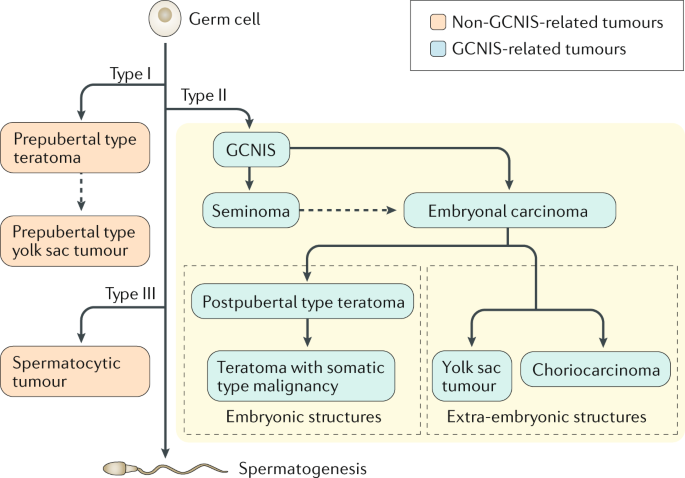Germ cell tumors are a type of cancer that originate from germ cells. Which are cells that develop into sperm or eggs. These tumors can occur in the ovaries, testes or other parts of the body where germ cells are present.
Germ cell tumors are relatively rare and account for only about 3% of all cancers. They are the most common type of cancer in young men aged 15-35 and in children. In women, germ cell tumors are most commonly diagnosed in their 20s and 30s.
Germ cell tumors can be benign or malignant. Benign germ cell tumors do not spread to other parts of the body and are not life-threatening. While malignant germ cell tumors can spread to other parts of the body and can be life-threatening.
The treatment for germ cell tumors depends on the location and stage of the tumor, as well as the patient’s age and overall health. Treatment may involve surgery, chemotherapy, radiation therapy or a combination of these approaches. With early diagnosis and appropriate treatment, the outlook for patients with germ cell tumors can be quite good.
Germ Cell Tumours In Kids
It can occur in children, but they are relatively rare. Germ cell tumors are the most common type of cancer in children aged 0-4 years and 10-14 years. They can occur in the ovaries or testes. But they can also occur in other areas of the body, such as the brain or chest.
The symptoms of germ cell tumors in children depend on the location of the tumor. In ovarian germ cell tumors, the child may experience abdominal pain or swelling. While in testicular germ cell tumors, the child may have a lump or swelling in the scrotum. Germ cell tumors in other parts of the body may cause symptoms such as headache, nausea, vomiting or chest pain.
The treatment for germ cell tumors in children depends on the location and stage of the tumor. as well as the child’s age and overall health. Treatment may involve surgery, chemotherapy, radiation therapy or a combination of these approaches.
The prognosis for children with germ cell tumors is generally good. Particularly when the tumors are diagnosed and treated early. The long-term effects of treatment such as infertility, should be carefully considered and discussed with the child’s healthcare team.
Germ Cell Tumours symptoms

The symptoms of germ cell tumors can vary depending on the location of the tumor:
- A lump or swelling in the testicles or ovaries
- Abdominal pain or swelling
- Back pain
- Shortness of breath
- Chest pain
- Headaches
- Nausea or vomiting
- Constipation or diarrhea
- Changes in urination, such as blood in the urine or difficulty urinating
- Fatigue or weakness
- Unexplained weight loss
It is important to note that some germ cell tumors may not cause any symptoms, especially in the early stages. That is why regular check-ups with a healthcare provider are essential for detecting any possible signs of cancer early.
If you or someone you know experiences any of these symptoms, it is important to see a doctor for further evaluation. These symptoms may be caused by other conditions but it is important to rule out the possibility of a germ cell tumor.
Germ Cell Tumours Causes
The exact cause of germ cell tumors is not fully understood but it is believed to be related to genetic mutations that occur in germ cells during fetal development. These mutations can cause abnormal growth and division of germ cells, leading to the formation of tumors.
Some risk factors have been identified that may increase the likelihood of developing germ cell tumors are:
- Age: Germ cell tumors are most commonly diagnosed in children and young adults.
- Sex: Germ cell tumors are more common in males than females.
- Family history: Having a family history of germ cell tumors may increase the risk of developing these tumors.
- Cryptorchidism: This is a condition where one or both testicles fail to descend into the scrotum, and it is a known risk factor for testicular germ cell tumors.
- Klinefelter syndrome: This is a genetic disorder that affects males and is characterized by an extra X chromosome. Men with Klinefelter syndrome are at an increased risk of developing testicular germ cell tumors.
- HIV infection: People with HIV have an increased risk of developing germ cell tumors, particularly those located in the brain.
It is important to note that most people who have these risk factors do not develop germ cell tumors and not all people who develop germ cell tumors have these risk factors. In many cases, the exact cause of germ cell tumors remains unknown.
Diagnosis of a Germ Cell Tumour

Germ cell tumors (GCTs) are tumors that originate from the germ cells. Which are the cells that give rise to sperm and eggs. These tumors can occur in both males and females and can be benign or malignant. The diagnosis of a germ cell tumor usually involves a combination of medical history, physical examination, imaging studies and laboratory tests.
Medical history
The doctor will ask about the patient’s symptoms, including any pain, swelling, or other abnormalities. They will also ask about the patient’s medical history, including any previous cancers, surgeries, or treatments.
Physical examination
The doctor will perform a physical examination, which may include a pelvic or testicular exam. They will look for any lumps, masses, or other abnormalities.
Imaging studies
Imaging studies, such as ultrasound, CT scan, or MRI, may be used to visualize the tumor and determine its size and location. These tests can also help to determine whether the tumor has spread to other parts of the body.
Laboratory tests
Blood tests, such as tumor marker tests, may be used to detect the presence of certain proteins or hormones that are produced by some types of germ cell tumors.
Biopsy
In some cases, a biopsy may be necessary to confirm the diagnosis of a germ cell tumor. A small sample of tissue is removed from the tumor and examined under a microscope to determine if it is malignant or benign.
Germ Cell Tumor Treatment
The treatment of a germ cell tumor depends on the type of tumor, its location, stage and the patient’s overall health. Treatment options include:
- Surgery: Surgery is usually the first treatment for most types of germ cell tumors. The goal of surgery is to remove the tumor completely. In some cases, surgery may be combined with chemotherapy or radiation therapy.
- Chemotherapy: Chemotherapy involves the use of drugs to kill cancer cells. It may be used before or after surgery. Chemotherapy is often used for advanced or metastatic germ cell tumors.
- Radiation therapy: Radiation therapy uses high-energy radiation to kill cancer cells. It may be used alone or in combination with chemotherapy. Radiation therapy is usually used to treat seminomas.
- Stem cell transplant: Stem cell transplant involves the use of high-dose chemotherapy to destroy cancer cells followed by a transplant of healthy stem cells to replace the destroyed cells.
- Surveillance: Surveillance is used for some low-risk tumors that have been completely removed by surgery. Patients are closely monitored for any signs of recurrence.
Germ Cell Tumor Medication
There are several medications that may be used in the treatment of germ cell tumors. The type of medication used depends on the type and stage of the tumor, as well as other factors such as the patient’s age and overall health. Some common medications used in the treatment of germ cell tumors include:
- Chemotherapy drugs: Chemotherapy drugs are used to kill cancer cells. Some commonly used chemotherapy drugs for germ cell tumors include cisplatin, etoposide, bleomycin, and ifosfamide.
- Hormone therapy: Hormone therapy is sometimes used to treat certain types of germ cell tumors. For example, some testicular germ cell tumors produce hormones that can be targeted with hormone therapy.
- Immunotherapy: Immunotherapy is a type of treatment that uses the patient’s own immune system to fight cancer. Some immunotherapy drugs, such as pembrolizumab and nivolumab, have been approved for the treatment of some types of germ cell tumors.
- Targeted therapy: Targeted therapy is a type of treatment that targets specific proteins or genes that are involved in cancer growth. Some targeted therapies, such as bevacizumab, have been approved for the treatment of some types of germ cell tumors.
Conclusion
Germ cell tumors are a type of cancer that can occur in both men and women and can be either benign or malignant. Treatment options depend on the type and stage of the tumor, and the prognosis for germ cell tumors can vary based on various factors. It is important to consult with a healthcare professional if you suspect you have a germ cell tumor or any other medical condition.


